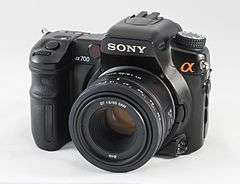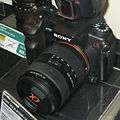Sony Alpha 700
 | |
| Overview | |
|---|---|
| Type | Digital single-lens reflex camera |
| Lens | |
| Lens | interchangeable, Sony α / Konica Minolta A mount |
| Sensor/Medium | |
| Sensor | 12.4 effective megapixels CMOS |
| Maximum resolution | 4288 × 2856 pixels |
| ASA/ISO range | Auto, 100, 200, 400, 800, 1600, 3200, 6400 |
| Storage | CompactFlash I/II, Memory Stick Duo, Memory Stick PRO Duo |
| Focusing | |
| Focus areas | 11-points, center double cross-hair |
| Flash | |
| Flash | Built in |
| Shutter | |
| Shutter speed range | 30s - 1/8000s, Bulb. X-sync 1/250s (without Steadyshot), 1/200 (with Steadyshot) |
| Continuous shooting | 5 frames per second (JPEG, JPEG+RAW, cRAW, RAW) |
| Viewfinder | |
| Viewfinder | 95% coverage, 0.9x magnification |
| General | |
| Rear LCD monitor | 921K-point (307k pixel), 3-inch TFT LCD |
| Battery | lithium ion battery pack |
| Weight | 690 g (24 oz) (without battery) |
| Made in | Japan |
Sony α 700 (DSLR-A700) was the second model launched in the Sony α series of digital single-lens reflex cameras. This model appeared to reuse some technology of the former Konica Minolta Maxxum 7D (e.g. same man-machine command interface/commands, similar LCD menus, very similar viewfinder and compatible Sony-Konica-Minolta lenses)
On March 8, 2007, at the PMA Trade Show, Sony announced two new α cameras, both positioned to be "above" the α100 in the Alpha line-up. One model was referred to as a "high amateur" model, with a release date of late 2007. The A700 was discontinued, and its successor, the A77 (SLT-A77), was announced on August 24, 2011, with availability from October 2011.[1]
Release
On September 6, 2007, Sony announced that the Sony α700 would be launched on November 16, 2007. However, the Sony A700 went on sale almost immediately. By the end of Sept 2007, the A700 could be ordered from SonyStyle.com or purchased at most BestBuy locations.[2] Featuring the Exmor CMOS sensor with 12.24 Mpixels capable of images at a maximum of 4288 × 2856 resolution, together with a BIONZ image processor for supporting RAW noise reduction and ISO 3200 and 6400 boost sensitivity. Also featuring HDMI output and a magnesium alloy and polycarbonate body. The camera has the combo with the DT16-105 lens kit (DT 16-105mm F3.5-5.6) at ¥230,000, also the body only camera option at ¥180,000.
Noise reduction
The A700 initially received criticism from the review community for their "cooked raws", a function that kept the noise reduction algorithm on in the image on high ISO even on Raw files, hence, "cooked" into the raw data. Shortly after the release, Sony released a series of successive firmware updates, finally ending on version 4 which improved function, including allowing a variable setting for noise reduction including the option to turn it off; the cooked raw problem was no longer an issue. Some other improvements were exposure bracketing extended 2 EV, and high ISO image grain improved.[3]
Comparison with α 350
The α 700 has a lower pixel resolution than the later α 350, which includes some extra features (Live preview mode, automatic pop-up flash) and a much lower price. However, the α 700 uses a pentaprism viewfinder instead of a pentamirror, has a higher burst speed (5 frame/s vs 2.5 frame/s), has a higher resolution LCD screen, magnesium alloy body, twin control dials, better environmental seals, dual flash media slots (CF and MS-DUO), a PC Sync socket, more autofocus points and a stronger AF motor, and HDMI output. The A350's sensor was also a CCD sensor, as opposed to the A700's Exmor CMOS unit, the A700's sensor having superior low light, high ISO performance. All in all the A700 is considered the superior camera despite the slight megapixel shortage.[4]
References
- ↑ http://www.dpreview.com/previews/sonyslta77/
- ↑ "Sony Alpha SLR cameras" (Press release) (in Japanese). Sony Japan. September 6, 2007. Retrieved September 6, 2007.
- ↑ http://www.imaging-resource.com/PRODS/AA700/AA700A5.HTM
- ↑ http://www.imaging-resource.com
External links
![]() Media related to Sony DSLR-A700 at Wikimedia Commons
Media related to Sony DSLR-A700 at Wikimedia Commons
Reviews
| Minolta/Konica Minolta/Sony DSLR and SLT A-mount timeline | |||||||||||||||||||||||||||||||||||||||||||||||||||||||||||||||||||||||||||||||||||||||||||||||||||||||||||||||||||||||||||||||||||||||||||||||||||||||||||||||||||||||||||||||||||||||||||||||||||||||||||||||||||||||||||||||||||||||||||||||||||||||||||||||||||||||||||||||||||||||||||||||||||||||||||||||||||||||||||||||||||||||||||||||||||||||||||||||||||||||||||||||||||||||||||||||||||||||||||||||||||||||||||||||||||||||||||||||||||||||||||||||||||||||||||||||||||||||||||||||||||||||||||||||||||||||||||||||||||||||||||||||||||||||||||||||||||||||||||||||||||||||||||||||||||||||||||||||||||||||||||||||||||||||||||||||||||||||||||||||||||||||||||||||||||||||||||||||||||||||||||||||||||||||||||||||||||||||||||||||||||||||||||||||||||||||||||||||||||||||||
|---|---|---|---|---|---|---|---|---|---|---|---|---|---|---|---|---|---|---|---|---|---|---|---|---|---|---|---|---|---|---|---|---|---|---|---|---|---|---|---|---|---|---|---|---|---|---|---|---|---|---|---|---|---|---|---|---|---|---|---|---|---|---|---|---|---|---|---|---|---|---|---|---|---|---|---|---|---|---|---|---|---|---|---|---|---|---|---|---|---|---|---|---|---|---|---|---|---|---|---|---|---|---|---|---|---|---|---|---|---|---|---|---|---|---|---|---|---|---|---|---|---|---|---|---|---|---|---|---|---|---|---|---|---|---|---|---|---|---|---|---|---|---|---|---|---|---|---|---|---|---|---|---|---|---|---|---|---|---|---|---|---|---|---|---|---|---|---|---|---|---|---|---|---|---|---|---|---|---|---|---|---|---|---|---|---|---|---|---|---|---|---|---|---|---|---|---|---|---|---|---|---|---|---|---|---|---|---|---|---|---|---|---|---|---|---|---|---|---|---|---|---|---|---|---|---|---|---|---|---|---|---|---|---|---|---|---|---|---|---|---|---|---|---|---|---|---|---|---|---|---|---|---|---|---|---|---|---|---|---|---|---|---|---|---|---|---|---|---|---|---|---|---|---|---|---|---|---|---|---|---|---|---|---|---|---|---|---|---|---|---|---|---|---|---|---|---|---|---|---|---|---|---|---|---|---|---|---|---|---|---|---|---|---|---|---|---|---|---|---|---|---|---|---|---|---|---|---|---|---|---|---|---|---|---|---|---|---|---|---|---|---|---|---|---|---|---|---|---|---|---|---|---|---|---|---|---|---|---|---|---|---|---|---|---|---|---|---|---|---|---|---|---|---|---|---|---|---|---|---|---|---|---|---|---|---|---|---|---|---|---|---|---|---|---|---|---|---|---|---|---|---|---|---|---|---|---|---|---|---|---|---|---|---|---|---|---|---|---|---|---|---|---|---|---|---|---|---|---|---|---|---|---|---|---|---|---|---|---|---|---|---|---|---|---|---|---|---|---|---|---|---|---|---|---|---|---|---|---|---|---|---|---|---|---|---|---|---|---|---|---|---|---|---|---|---|---|---|---|---|---|---|---|---|---|---|---|---|---|---|---|---|---|---|---|---|---|---|---|---|---|---|---|---|---|---|---|---|---|---|---|---|---|---|---|---|---|---|---|---|---|---|---|---|---|---|---|---|---|---|---|---|---|---|---|---|---|---|---|---|---|---|---|---|---|---|---|---|---|---|---|---|---|---|---|---|---|---|---|---|---|---|---|---|---|---|---|---|---|---|---|---|---|---|---|---|---|---|---|---|---|---|---|---|---|---|---|---|---|---|---|---|---|---|---|---|---|---|---|---|---|---|---|---|---|---|---|---|---|---|---|---|---|---|---|---|---|---|---|---|---|---|---|---|---|---|---|---|---|---|---|---|---|---|---|---|---|---|---|---|---|---|---|---|---|---|---|---|---|---|---|---|---|---|---|---|---|---|---|---|---|---|---|---|---|---|---|---|---|---|---|---|---|---|---|---|---|---|---|---|---|---|---|---|---|---|---|---|---|---|---|---|---|---|---|---|---|---|---|---|---|---|---|---|---|---|---|---|---|---|---|---|---|---|---|---|---|---|---|---|---|---|---|---|---|---|---|---|---|---|---|---|---|---|---|---|---|---|---|---|---|---|---|---|---|---|---|---|---|---|---|---|---|---|---|---|---|---|---|---|---|---|
| |||||||||||||||||||||||||||||||||||||||||||||||||||||||||||||||||||||||||||||||||||||||||||||||||||||||||||||||||||||||||||||||||||||||||||||||||||||||||||||||||||||||||||||||||||||||||||||||||||||||||||||||||||||||||||||||||||||||||||||||||||||||||||||||||||||||||||||||||||||||||||||||||||||||||||||||||||||||||||||||||||||||||||||||||||||||||||||||||||||||||||||||||||||||||||||||||||||||||||||||||||||||||||||||||||||||||||||||||||||||||||||||||||||||||||||||||||||||||||||||||||||||||||||||||||||||||||||||||||||||||||||||||||||||||||||||||||||||||||||||||||||||||||||||||||||||||||||||||||||||||||||||||||||||||||||||||||||||||||||||||||||||||||||||||||||||||||||||||||||||||||||||||||||||||||||||||||||||||||||||||||||||||||||||||||||||||||||||||||||||||
